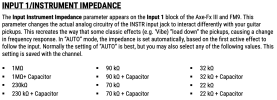charliepratt
Member
I know this discussion has been had a few times, and I may be operating from bias here... but I have two 10-ft Mogami cables in front of my Axe FX III, with an inactive Boss OD-3 in between (It's my favorite subtle OD, and I add it onto certain presets at various times).
When I plug straight into the Axe FX, it's great. When I plug in with the Boss OD-3 acting as a buffer, everything sounds...better to my ear. I have pretty high end Neumann monitors set up in my studio and have tested it in Logic.. I don't hear any unwanted noise when I include the Boss pedal in the chain in front. And to my ears, everything sounds just a bit brighter and with the kind of clarity I like.
Do I need to just pull the OD-3 out of the chain, and adjust my presets accordingly? Or is the buffer in the OD-3 actually doing something pleasing that I can't get otherwise?
Thanks @FractalAudio. You guys seriously rule.
When I plug straight into the Axe FX, it's great. When I plug in with the Boss OD-3 acting as a buffer, everything sounds...better to my ear. I have pretty high end Neumann monitors set up in my studio and have tested it in Logic.. I don't hear any unwanted noise when I include the Boss pedal in the chain in front. And to my ears, everything sounds just a bit brighter and with the kind of clarity I like.
Do I need to just pull the OD-3 out of the chain, and adjust my presets accordingly? Or is the buffer in the OD-3 actually doing something pleasing that I can't get otherwise?
Thanks @FractalAudio. You guys seriously rule.

